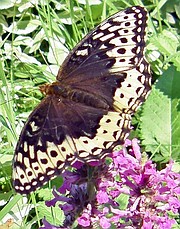Don’t allow chemicals to destroy garden safety
I just received a call from a reader requesting a repeat of the following information I gleaned over time from myriad sources. I’m honoring her request because there’s still been no change in attitude on the part of big bully chemicals, determined to undermine safe, natural gardening. Read on:
- “Any gardener who is not brain-dead knows that all our pollinators are in terrible danger – not only from the destruction of habitats and over-use of herbicides, “pesticides” and now the sale of pre-poisoned plants themselves – under the pretty sounding name of neonics. Over the years, I’ve studied and researched nature’s gifts of creatures, plants and birdlife, finding problems and possible solutions, and passing them on to you, the (gardening) readers. We all realize those gifts – especially the vital pollinators – are in terrible danger, and have been for some time; all for the tradeoff of profit to greedy, completely unscrupulous chemical companies.
First, consider the information printed on a plant stick taken from a garden plant purchased locally.
Side 1: “This plant is protected from problematic aphids, whiteflies, beetles, mealy bugs and other unwanted pests by Neonicontinoids”; (Regarding side 1 – “beetles” – ladybugs are beetles which feast on also-listed aphids and are certainly not an “unwanted pest.”)
Side 2: “Treated with neonicotinoids. These pesticides are approved by the EPA. For more info. please visit us at ecooptions.homedepot.com/healthyhome/gardening.”
This, while bone-chilling, gives us the clarion call to read labels.
Now, let me repeat the release from the Natural Resources Defense Council in direct quotes.
“Bees are dying at an alarming rate awash in a deluge of next-generation pesticides unleashed by agri-chemical giants like Bayer, Monsanto and Syngenta … Since 2006, as many as 35 percent of all bee colonies have collapsed in a single winter, with some regions reporting die-offs of 50 percent or more. Now, the science is in, and it leaves no room for doubt or delay. The world’s most widely used class of insecticides – called ‘neonics’ – is a key factor in the devastating collapse of bee colonies … in fact, some of the neonics are 5,000 to 10,000 times more toxic to bees than DDT … more than 70 out of 100 major crops are pollinated by bees, not to mention the abundance of flowers and vegetables that bees pollinate in millions of backyard gardens across America.
“Neonics are now the most heavily used class of insecticides in the U.S. (having been wisely banned in England and EU) and is applied to an estimated 150 million acres of crops each year. Neonics are systemic, once absorbed into a plant’s tissue, they turn that plant into a tiny ‘poison factory’ that emits toxins all the way from its roots to its nectar – on which bees then feed. The poison is ruthlessly indiscriminate, killing a slew of beneficial insects – ranging from bees and butterflies to ladybugs and dragonflies … “
There’s much more to this sickening story; please educate yourself and together perhaps something can be done. Go to nrdc.org/savebees. Meanwhile, let us at least do our part in keeping this little part of the world clean and free of pesticides. Use organic methods and let the bees and other beneficials do their work. Buy garden plants and supplies at real nurseries – not big store displays.
Truly, what’s sweeter or more satisfying than going out among your flowers in summertime and seeing the precious pollinators at work? Butterflies on the Valerian, bees in the Clematis, hummingbirds in the Lobelia – dragonflies also carry pollen and many other beneficial creatures – while non-pollinators, are working behind (or under) the scenes in the soil to keep it healthy. Beetles, spiders, garden snakes, toads, and rarely-seen tiny salamanders all do their share in maintaining a healthy, vibrant garden – whether you appreciate them or not. Welcome them all and don’t thwart their good works with ‘cides.
Simply keeping your soil rich with mulch will make it friable and nurturing for plants – and in turn, the pollinators. Make your garden a safe refuge for bees, butterflies and hummingbirds
Following is a list of flowers that are beloved of those intrepid little workers – all should be hardy here; some are native, some are cultivars – but all will nurture the pollinators while providing beauty for your landscape. Start your list now for a friendly, healthy garden this upcoming season.
Hummingbirds: Coralbells (Heuchera) – long a garden staple, coralbells come in a fabulous array of varieties and glorious leaf color with masses of tiny flowers that also draw bees;
Scarlet gilia (Ipomopsis aggragata) – the classic magnetic bright red florets now come in shades of orange, purple, pink and white as well; Cardinal flower (Lobelia cardinalis) – considered the quintessential hummingbird plant, the red native blooms in summer and early fall, with cultivars available in many colors; Honeysuckle (Lonicera) – the orange native is beloved by hummers and bees with its long tubular orange flowers, with cultivars in yellow and red as well;
Bee balm (Monarda) – this bright red favorite of herbalists is now available in many other colors, with the purple cultivar favored by the bees; Penstemon – this genus is long-lasting and P. barbatus blooms in the summer when Rufous hummingbirds are migrating.
Bees: It’s hard to nail down bee-loved flowers, since there are so many types of pollinating bees and almost every flower appeals to one of them. You’ll find them on all trumpet-shaped flowers from those listed above, as well as Campanula, Columbine, native Clematis and lilies, along with open-faced pollen-laden flowerheads such as Peonies, Valerian, Angelica, Yarrow and other umbellifers , and multi-flower covered heads like Liatris, Betony, Veronica and Pulmonaria. Basically, “If you plant it, they will come.”
Butterflies: Caveat: If you plant a butterfly garden, remember that they lay eggs that become larvae/caterpillars – and if you wipe those out you are defeating the purpose of a butterfly garden. They lay their eggs in clusters on the bottom of leaves – if you find some, let them be. Too, remember the endangered Swallowtail butterfly begins as a handsome green caterpillar with black stripes that loves parsley (often called “Parsley worm”. Simply plant extra parsley, or use some as an ornament in your flower garden and welcome them.
Butterfly weed (Asclepias) – a great native shrub with butterfly-drawing orange flowers – now available in beautiful cultivars of red and pink. (Some butterfly larvae forage on this plant and don’t do any damage; let them be). Purple coneflower (Echinacea); Sages of all ilk from culinary to Salvia; Sweet William (Dianthus); Phlox; Black-eyed Susan (Rudbekia); Mallows (Malva) hollyhocks; Lupine; Roses.
As you can see, most any flower will be accepted by at least one pollinator – so design your plantings with perhaps a little focus on reds – and select what’s best for your surroundings.
On now to the most serious matter.
We can begin by buying plants only from a professional nursery/greenhouse or grower. There are many in the area and they deserve your loyalty and support. Too, ask questions. Where do their plants come from? Even some top-notch nurseries may ship in plants they can’t grow themselves, unaware of the sources of their purchases. Awareness of possible dangers may be a saving key; it leads to knowledge – and hopefully that knowledge will lead to the power to overcome this tragedy.
Valle Novak writes the Country Chef and Weekend Gardener columns for the Daily Bee. She can be reached at bcdailybee@bonnercountydailybee.com or by phone at 208-265-4688 for questions between the hours of 8 a.m. to 6:30 p.m. a 208-265-4688.





